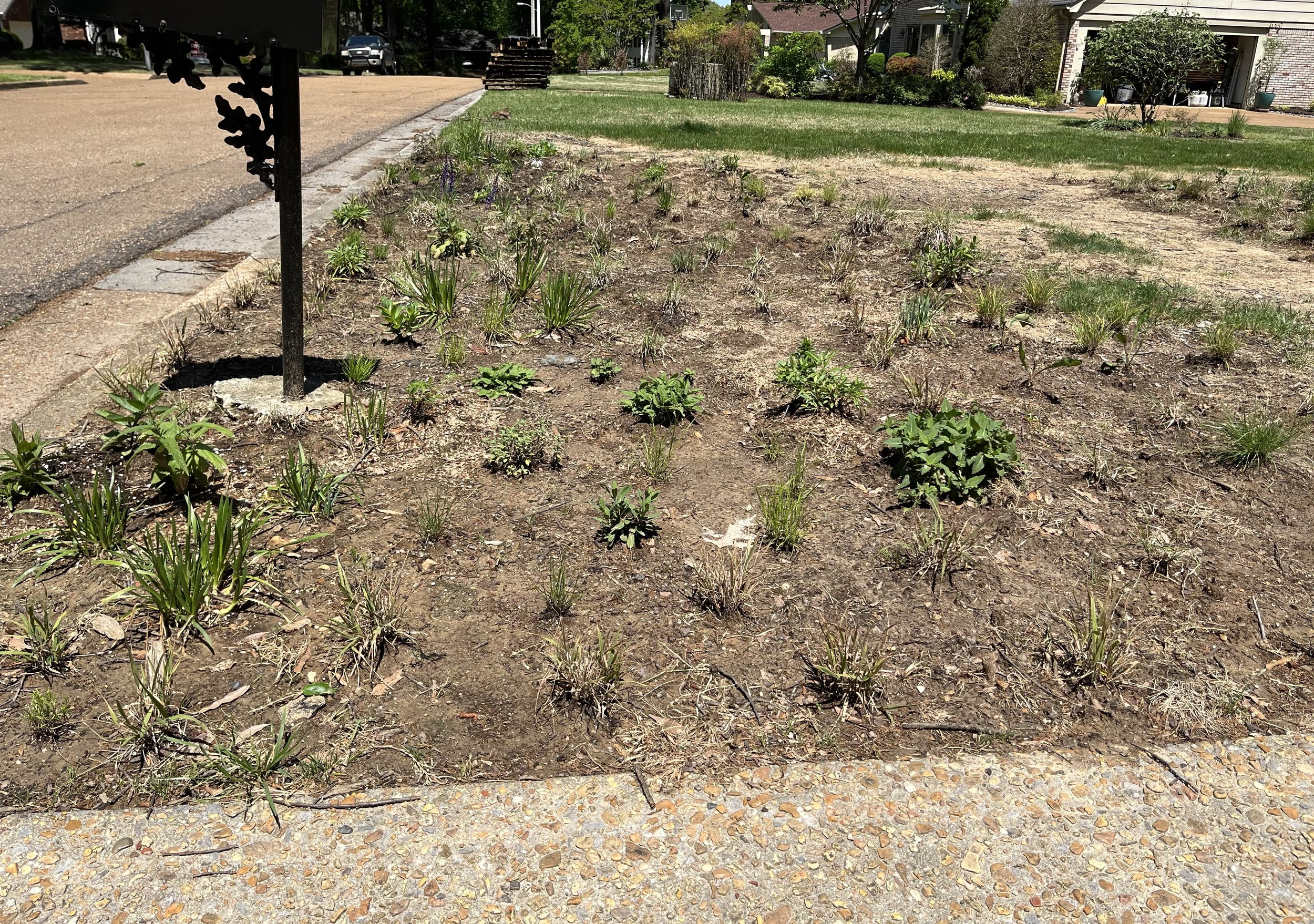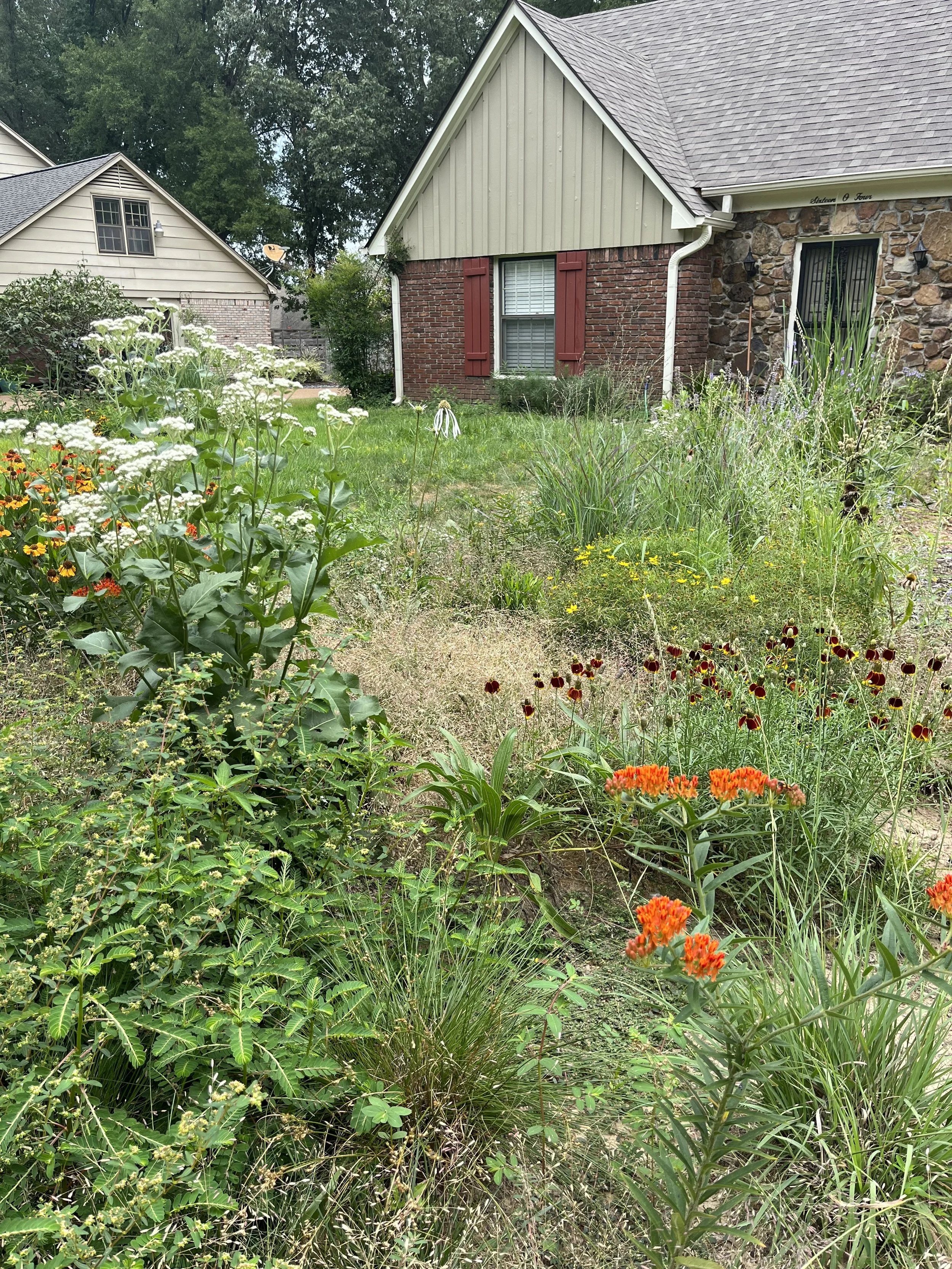Soiled Confessions of a Former Mulch Slinger.
Beep beeeeeeep.
That very well may be the sound of a Memphis landscaping crew backing their rig into your driveway to dump a sizeable mountain of woodchips, mulch, hot steamy compost, or garden mix in front of your home. Now before we start shoveling, a brief word on how we plant, the soil we plant into, and plant resiliency. Many of us are inspired to incorporate hard-working perennials that function not only ornamentally but also support wildlife. Even the most rugged of plants have their preferences when it comes to their surroundings, and so I have to keep this in mind as I look at garden locations and formulate patterns and plant combinations. To create a win-win environment for both the plants and the gardener, I constantly think about how I plant and also what I am planting into.
Southern Roots
In the Memphis area and Mid-South landscape, often plants struggle with having wet feet, and especially prefer to not have extremely wet feet over winter. I’ve seen a lot of plants croak due to this, both at my hands and others. Multiple factors come into play here, including our planting technique but also the soil we are planting into. Previously, I worked some with Gardens Oy Vey nursery out in Arlington, TN along with local master gardener Ceylon Mooney. They’re super smart, and I am so grateful for their wisdom, especially when it comes to care of plants. They rally behind their technique of planting up, mounding up at just the right amount to help prevent plant roots from sitting in too much damp soil. By mounding up a bit versus pressing that plant down to exact soil level (or lower) gives the plant’s root system a fighting chance to not drown in moisture and rot, given our specific conditions. The hope is to keep plants alive as long as possible. That’s how they taught me to plant, beat it into my head over and over, and I still frequently incorporate this today in a lot of situations. So - if you are working in a Mid-South garden bed this can definitely be a smart technique for planting. Diane Meucci of Gardens Oy Vey once looked me right in the eyes and said, “treat the plant like a masterpiece”, with a certain seriousness that you knew she meant those words. Indeed. And so it became my experience that each plant is a masterpiece and I still plant with that in mind today. They taught me that how we plant matters. But what we are planting into matters as well. So let’s continue to dig down further into soil and plant resiliency.
Meadowscaping a front yard lawn in Germantown TN. After the planting was designed, the sod was stripped, and plants installed with no soil amendments added.
Young planting slowly developing in average soil. Germantown, TN.
A simple lesson.
We gardeners are a determined bunch, pushing pallets of bagged black stuff and bagged brown stuff and possibly other fascinating colors out of the box stores, loading down our trunks and our backseats and also our frontseats, and then dumping it into our gardening beds. In Mid-South gardens, some of our perennial forbs and grasses are given the royal treatment - heavily amended soil when they really may not need it or want it at all, or at least not so much of it. Hiking wild areas and looking at plants out in the wild demonstrates this. Although in our home gardens, we are not out in the wilderness, there are still valuable lessons that we can mimic. Out of curiosity, I began experiments on plant responses to a variety of soil types. I originally started my tests on hellstrips and medians both at home and guerilla gardening around the city elsewhere. Often, I was taking multiple perennials and sticking them into the ground without amending the soil. Just plopping them in around the city. Some would not make it but many did. Many perennials not only tolerated it, but their root systems thrived and these plants continued to come back. The more I did this, the more I found myself amending garden beds less and less at home. I had such a positive experience with this that today my preference is to seek out and design with hard-working ornamental plants that do well in these conditions, and the vast majority of my planting in my home garden does not contain additional amendments tilled into the soil or added as topsoil.
The lesson plants are teaching me:
Plants do a better job at amending the soil around their own feet than we landscapers do.
Soil Vibe Check.
In the context of residential landscaping bed installation, we may frown at the thought of what seems like a problematic heavy clay foundation. But let’s take a second to revisit our “poor soils” and “average soils”. A yard that has maintained a sodded turf, or sections with former trees and shrubs - this earth will have over time experienced slow and incremental changes to the makeup of the topsoil. Peel up some sod grass and inspect that soil. You’ll notice this soil is of a different consistency than that of say, a dirt road. Inspect the soil where a former oak tree fell or was removed - that soil is self-amended, nicely, and it looks and feels and possibly smells very different than when a landscaping crew hauls in pre-mix, or takes pine bark mulch - combines that with a lump of steamy compost, and possibly sand, and then tills their own special recipe into a garden bed. These heavily amended garden beds create environments that I would argue can at times be a little too good at capturing and holding on to moisture in the soil. So I encourage you to try planting directly into your average soils! It just hits different.
Have you hugged a farmer today?
And this brings us to a few lessons that regenerative agriculture farmers can teach us plant designers and ornamental gardeners about soil. These farmers are serious about soil health - they have to be — as they recognize that healthier soil translates to healthier yields. Using a variety of regenerative techniques with and without animals, these farmers are healing topsoil, and where it gets really impressive is that they are often reversing sites prone to serious erosion. Here are just a few tools in their kit worth a closer look.
1. No Till Systems - For ornamental garden beds, it is not uncommon for landscapers or gardeners, whether using hand tools or machines, to till up an entire area for the creation of a garden bed. Tillage pulverizes the existing structure and alters the makeup of the existing area of soil. If we don’t till, we keep the existing soil structure largely intact and reduce disturbance to the soil and seed bank. Instead, digging individual plug-sized holes vs. broad tillage lessens the impact of soil disturbance and can reduce opportunistic weeds tucked away in the seed bank lying in wait for your precious garden.
2. Chop-n-Drop Mulching - For a home garden situation where immaculate may not be a requirement, when you do plant and grass cut-backs: allow some of the clippings to fall around the plants. It will act as a mulch, retain some moisture, further helping reduce weeds, and as it decomposes will help improve the soil around it. I encourage you to try this around hard-working perennials plants and grasses - and use less bark mulch.
3. S.T.U.N. Method - (Sheer-Total-Utter-Neglect) - I throw this one in partially out of humor but there is some value to it. Mark Shepard of New Forest Farm coined this concept, but essentially, the idea in his mimic of oak savannas is to select the plants that demonstrate they want to be in that location and to continue working with them. To put down lots and lots of plants in close proximity, with little intervention, and then continue to work with the plants that really thrive and want to be in that particular environment. We can do similar things in our ornamental garden spaces. Plant tons of plants close together, observe who really wants to be there and then continue to use those plants. There are hard-working plants from all plant families that will let you know that they want to be there. And you may find that as a result you are having less anxiety, for example - about our freezes in early Spring. Hey you over there - carefully draping blankets over your in-ground plants - are you good??
:) Happy Spring, Y’all! - Joel
Feel free to shoot me, or shoot me a line here: songbirdmeadowscapes@gmail.com


